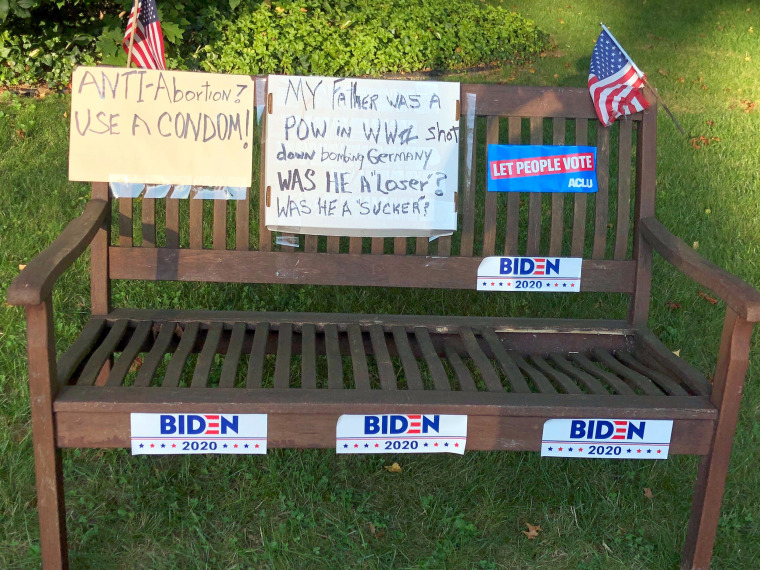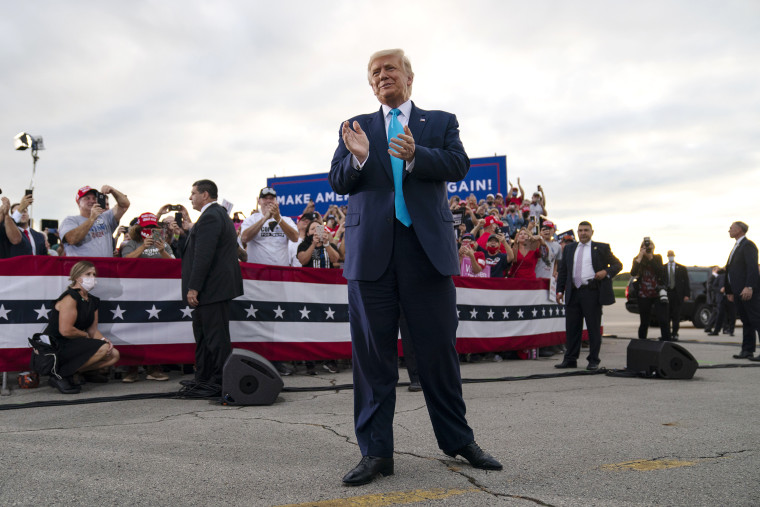MT. LEBANON, Pa. — In Pittsburgh and the surrounding counties, it's increasingly clear how close the contest is between President Donald Trump and Democratic rival Joe Biden.
Since April, the Pittsburgh metropolitan area has seen the third-highest level of TV and radio ad spending on the election of any metro area at more than $21 million, according to Advertising Analytics, trailing only Phoenix and Orlando, Florida. Roughly two-thirds of that spending is pro-Biden, while the remainder is for Trump.
Biden and Trump have upped their presence, too.
Last month, Biden chose Pittsburgh — site of his initial campaign event — to give his first address outside the Wilmington, Delaware, area since the pandemic took hold, making clear his condemnation for protest violence as well as his stance against an outright ban on fracking, an economic engine outside the city. The president made a visit days later to Latrobe, while Vice President Mike Pence and Eric Trump toured the area last week.
"There's a couple of million people out here in the southwest that are pretty independent minded, have historic connections to the labor movement and kind of working-class Democratic politics, but maybe some more conservative individual beliefs," said Rep. Conor Lamb, D-Pa, referring to the southwest part of the state. "So you have to come and work for their votes."
On the ground, voters are anxious about where the country is heading and are leery of making any assumptions about how the election will play out here.
"The country is in a state of flux, and that's certainly felt around here," said former Rep. Keith Rothfus, R-Pa. "You're seeing the old coalitions splintering."
Speaking from her home in Mt. Lebanon, an upscale Pittsburgh suburb of more than 30,000, Janice Wolk, a Biden backer who supported Hillary Clinton in 2016, recalled having a sinking feeling that Trump would win in 2016.
"I just had this sense," she said. "I can't tell you exactly why. Just you sense sometimes, you get vibrations."
Wolk, 74, doesn't have that same feeling this time around, but said she's "never seen anything like this current time."
"I don't recall this anger," she said. "It's just like everybody's been a pot on the boil ... just seething with anger and resentment."
Wolk has watched her town trend leftward in recent years, particularly during the Trump administration. Driving through the suburb, Black Lives Matter yard signs can't be missed — notable in a town with relatively few Black households.
But about 20 miles away in neighboring Washington County — where Trump won more than 60 percent of the vote in 2016 — the president's supporters have a markedly different outlook on the social movements that have gained energy this summer.
"I'm just about tired of hearing Black Lives Matter," said Dave Clark, 70. "What about Irish lives? What about Australians? What about babies? Un-borns? What about those lives? Do they count? I guess not because it's a political agenda and the media keeps pushing it and pushing it."
The candidates' focus on the region makes sense. In the seven counties that make up the Pittsburgh metropolitan area — Allegheny, Armstrong, Beaver, Butler, Fayette, Washington and Westmoreland — Trump bested Clinton in 2016 by more than 58,000 votes. He won the state by about 44,000.
"This is a place that had an Obama-Trump voter," said state Sen. Pam Iovino, a Democrat representing suburban Pittsburgh. "So there is a persuasion to be made here (by Biden) and a vote to be had to change the outcome."
Biden's backers share a strong distaste for the president, criticizing him for policies such as separating families at the U.S./Mexico border, his handling of COVID-19, and his "lies," as voters said in recent interviews.
Bob Fleming, a 78-year-old retiree in Bridgeville, a Pittsburgh suburb, told NBC News he can't fathom how people are still backing Trump. He acknowledged the president has an edge on the economy locally "but all the other stuff, I think he's an idiot, and he lies so much."
"I can't take his word for anything," Fleming said. "If he says it, I assume it's a lie."
On the other hand, Trump's backers voice many of the same themes: annoyance with Black Lives Matter; criticism of some protester actions; fear of violence; and anger toward the media. In right-leaning circles, videos showing protesters yelling at diners at a Pittsburgh restaurant and a confrontation between a demonstrator and a McDonald's manager have taken off. Even the president has highlighted them and is including Pittsburgh in his anti-protest rhetoric.
In interviews last week, those voters made clear that while they don't always agree with the president, they like what he has accomplished.
Clark said Trump "has proved that he's tried to keep his promises."
"Maybe not the way we would have liked it, as fast as we want it, but he's been doing it," Clark said.
With the Philadelphia region firmly in the Democratic column, and the state's center a Trump hotbed, the candidates are duking it out here in the western part of the state. Trump managed to improve on Mitt Romney's 2012 result in the Pittsburgh metro by nearly 50,000 votes — easily nullifying Clinton's performance in Allegheny County, which topped Barack Obama's in 2012.
Yet, in 2018, Sen. Bob Casey, D-Pa., won more votes here than Clinton and Obama while his opponent pulled in just two-thirds of Trump's haul.
For Democrats, the goal is to shave Trump's margins in the counties surrounding Pittsburgh — and they hope Biden's working-class persona and union bona fides can help pull it off. Republicans point to what they see as encouraging GOP voter registration numbers as proof Biden will have difficulty doing so while enthusiasm for Trump is high as ever, though they acknowledge that many of the updated registrations are longtime Democrats who voted for Trump in 2016 who are now changing their party affiliation to the GOP.
"They don't have to change their party registration (to vote) — they are actively choosing to," Nick Trainer, the Trump campaign's director of battleground strategy, said, "and that's a clear sign of the enthusiasm behind the president."
A top issue nationally, the pandemic has not hit the Pittsburgh area as hard as it has elsewhere, with the metropolitan area of nearly 2.5 million seeing roughly 18,000 cases and upward of 600 deaths. But the unemployment rate in six of the seven counties in the metropolitan area, as of June, had surpassed the national average, which was then at 11.2 percent. Blame for the economic conditions and the state of schools is aimed at Trump or Democratic Gov. Tom Wolf, depending on whom you ask.
The RealClearPolitics polling average shows Biden with a lead of more than 4 points in Pennsylvania, with a recent NBC News/Marist poll showing him up 9 points and performing better in its suburbs than Clinton. Voters, according to that survey, see Biden as better on race relations and COVID-19 than Trump, whom they credit as better on the economy. Meanwhile, more voters expressed concern about violence at protests than did about police misconduct, that NBC News/Marist poll found.
But the polls that showed Clinton winning here last time around turned out to be wrong. And many here think that could be the case in November, given a suspicion taking hold among neighbors that is relatively new in this politically diverse area. A Monmouth poll in July found that 57 percent of Pennsylvania voters believe there are secret Trump supporters in their communities, while 27 percent of voters believed the same about Biden supporters.
"It's weird but people have almost like ... a playbook that they have to follow or something," said former Rep. Melissa Hart, R-Pa. "You can't come out and talk to your neighbors because they might be Trump people or something. I mean, that's crazy."
There's something else different this time around, too — signs. Trump supporters are picking up "big signs, little signs, Trump merchandise, they want anything Trump," Washington County GOP Chairman Mark Hrutkay said, adding there is "anywhere between 50 and 100 fold more energy and enthusiasm in '20 versus '16."
But Biden also is making up ground in this low-tech campaign arena.
"In 2016, there were plenty of Trump signs in Erie County and Western Pennsylvania, where I live," said former Gov. Tom Ridge, a Republican who hasn't endorsed yet but is open to backing Biden."There were no Hillary Clinton signs. None. And now, as I drive around certain parts of Western Pennsylvania, there are least seem to be a comparable number of Biden signs."

Amid Trump's rhetoric aimed at scaring suburban voters like herself, Wolk, of Mt. Lebanon, is feeling a bit better about Biden's chances this fall.
"This is going to be an election based on the heart, people's souls," she said. "And do you have one, or do you not?"

